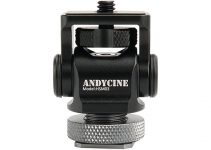NLEs are challenging to learn. Adobe Premiere Pro is one ultra-common pick and it is loaded up with a near-endless array of controls and settings that can help you tweak your footage to be just right. They also likely have hidden settings buried underneath other options. Essentially, I’m just trying to say there is always something new to learn about your editing software.
Filmmaker Aidin Robbins has been delivering outstanding tips on how to make better use of Premiere. His latest focuses on how to make better edits. This includes everything from smoothing out animations to better color to exporting. It’s a great mix of tips.
One thing I appreciate about Robbins approach is that he organizes his tips from the beginning of the edit and getting set up and then goes all the way to final exports.
1. Work and Export in 4K
Getting everything into a 4K timeline offers plenty of advantages, even if you are only shooting in HD. By working in a greater resolution you are preserving as much detail as possible and since most video is ending up online, it helps a lot when it comes to compression. Also, any graphics or text you throw up will be in native 4K and should be super crisp on your final product.
There’s also the nice side effect of getting the little 4K option and tag in YouTube, which just might convince people to click on it.
2. Try Editing in 18:9 (2:1)
Robbins throws out the idea of editing in an even wider aspect ratio than normal. In his case he uses 18:9, or 2:1.
This is becoming increasingly common as it provides a more cinematic look without going all the way to the ultra-wide 2.39:1 movies tend to you. It also more closely aligns with modern smartphone displays which seem to be getting wider and wider. Maximizing screen real estate is great.
3. Camera Lens Blur Instead of Gaussian Blur
For getting that smooth blur effect you should look into camera lens blur instead of the default of gaussian blur. Premiere doesn’t offer this option in its software so you’ll have to turn to After Effects, but the camera lens blur simply looks a bit more natural.
It’s a little different and worth a shot for improving the look of your effects. The only real concern is that it requires a good deal of power. To mimic this effect with less power you can use the Fast Box Blur and set iterations to 1.
4. Desaturate Blacks and Whites
Performing more global edits to the color of your footage you’ll likely end up introducing slight casts to areas of the scene you didn’t want to change.
The blacks and white in particular are susceptible to this. For these sections you can use a quick coloring option to desaturate them, which is likely the ideal move anyway as there is likely little color in the brightest and darkest sections of your image.
Using the Luma vs Sat curve in Lumetri Color all you need to do is pull down the dark and light areas of the image. It’s quick and works very well. Just add it on an adjustment layer over the entire timeline.
5. Horizontal Flip Effect
To maintain smoothness in the edit you may want to consider the horizontal flip effect. The example Robbins gives is when you have a series of clips where two of them feature movement from left to right and one moves from right to left.
By applying a horizontal flip to the outlier you can maintain the same movement direction and keep the flow of your video. It doesn’t always work but it’s worth remembering.
6. Keyframe Interpolation (Ease In and Out)
When you do a keyframe animation it defaults to a fixed, constant speed. To smooth out your animation you just have to apply a quick ease in and ease out. Select your first keyframe, right click, and choose Ease In.
Then do the same but Ease Out on your final keyframe. This should make it start slow, speed up, and then slow down. It helps the animation look a lot more professional. You can also control the settings to make it worth just how you like. It’s quite easy to just pull the curve as you want.
7. Transform Effect
Using the transform effect allows you to adjust scaling, skew, and more. What it can be useful for is adding some motion blur into your animations as Premiere offers a Shutter Angle option.
Set it to 180 and you’ll get a quick and painless blur that matches up with actual footage. It can also hide some of the less smooth parts of the animation. Another thing with the transform tool is that it can be used to adjust position and size without messing up keyframes.
8. Editing for Widescreen Aspect Ratio
Widescreen projects (think 2.39:1) that use 16:9 footage are actually easier to edit in a 16:9 timeline with black bars blocking the top and bottom. The reason for this is that when you nest clips into the widescreen timeline you lose the top and bottom information on your videos.
However, in the 16:9 timeline you can reposition as you want using the bars as a reference. Then, when you are ready to export you make a new widescreen timeline, drop your sequence into it, and it is ready to export in the proper ratio.
The extra footage also enables some smooth pans to the footage without losing any detail. Robbins likes doing it for drone footage to effectively add a tilt effect to static footage. It’s making use of the entire frame you captured.
9. Make Sure Footage Exports the Way it Looks as you Edit
I’ve definitely seen and been asked about this problem before. You export, all the settings look right, but you just can’t get the export to look as good.
The way to fix that is to go to your General preferences and turn on “Enable Display Color Management.” Following that you’ll need to download Adobe’s Gamma Compensation LUT, and then apply it to your footage at export. This should keep everything matched up in the export.
10. Quickly Adjusting for Premiere’s Export Changes
If you have already done all your grading changing these settings will require you to go back and regrade to get everything looking the same.
Or, the cheating way is to just compensate for Premiere’s changes in your initial edit. Robbins found that setting contrast to 5, saturation to 120, and tint to 2 does a decent job of matching up. It’s still not perfect though.
11. Increase the Bitrate
The default export settings in Premiere are very conservative at just 10 Mb/s. Going up to about 30 Mb/s will preserve a lot more detail in your export. It’s a simple and easy fix, but it does mean larger file sizes.
That’s a lot of great tips for people who are both new to editing and those with a bit of experience. Well worth a watch. Do you have any of your own tips to share?
[source: Aidin Robbins]
Order Links:
Disclaimer: As an Amazon Associate partner and participant in B&H and Adorama Affiliate programmes, we earn a small comission from each purchase made through the affiliate links listed above at no additional cost to you.



